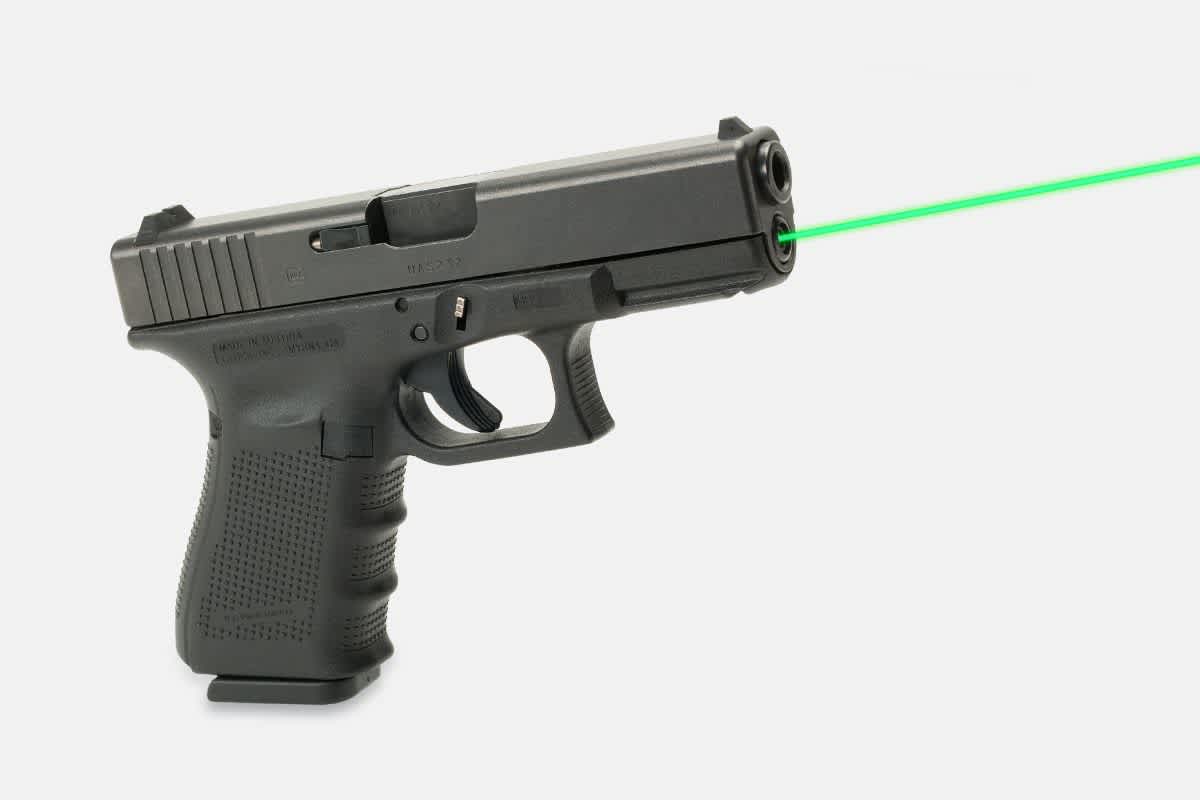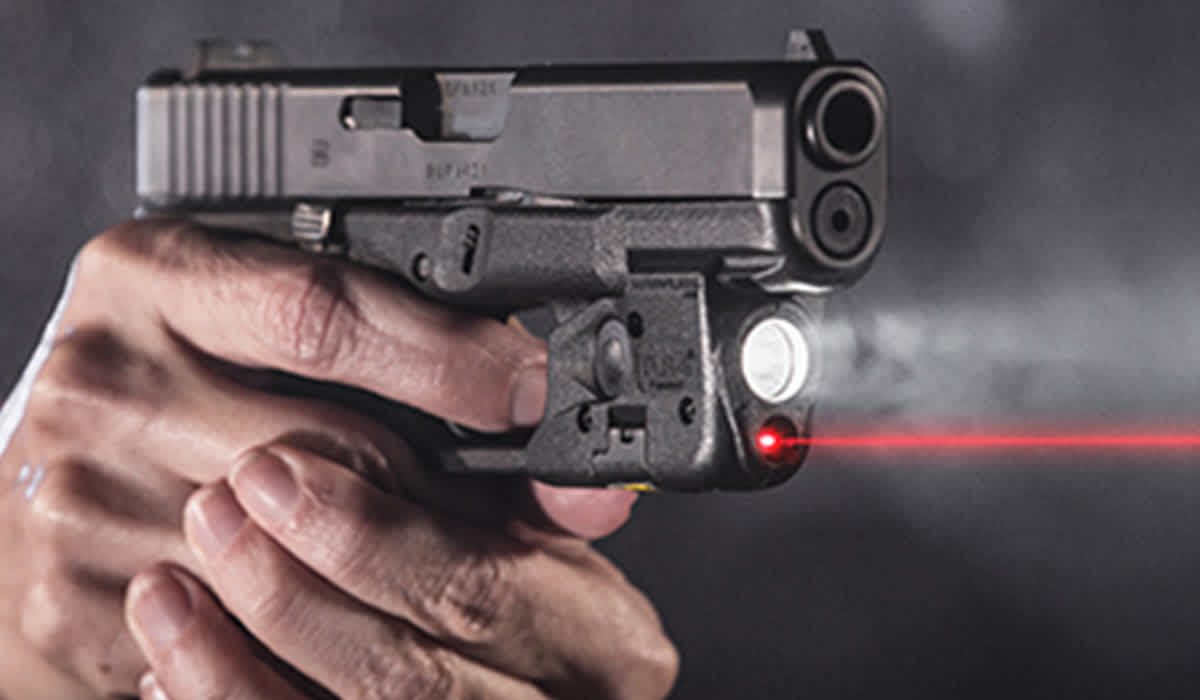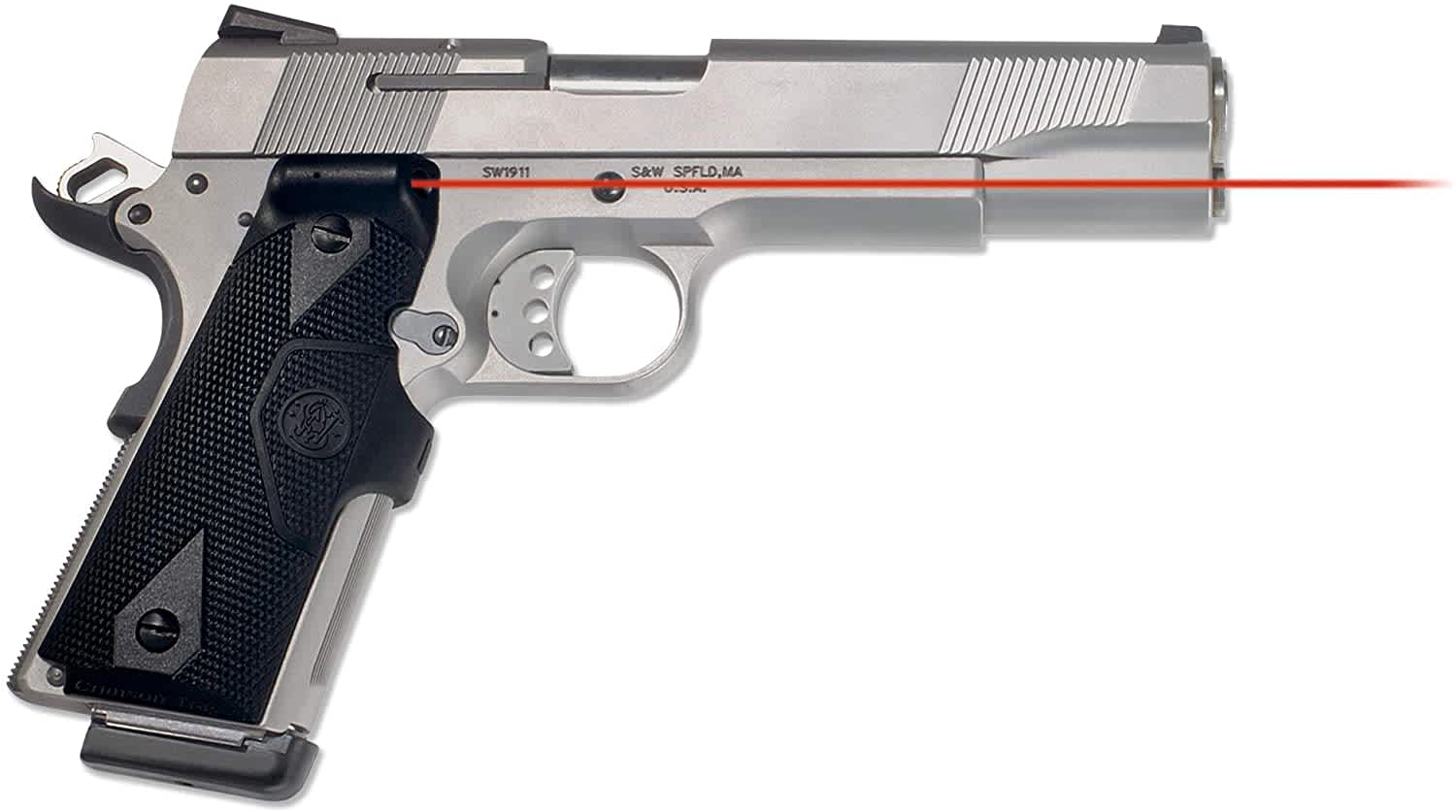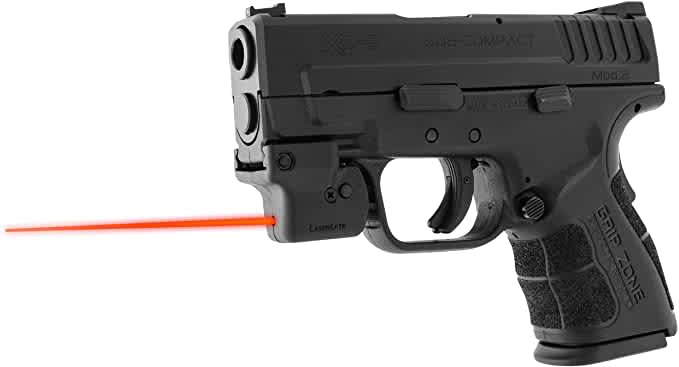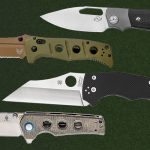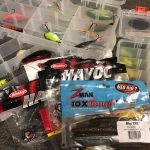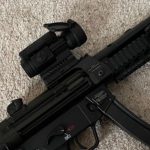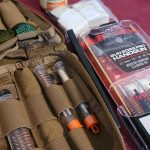The Best Pistol Laser Sights
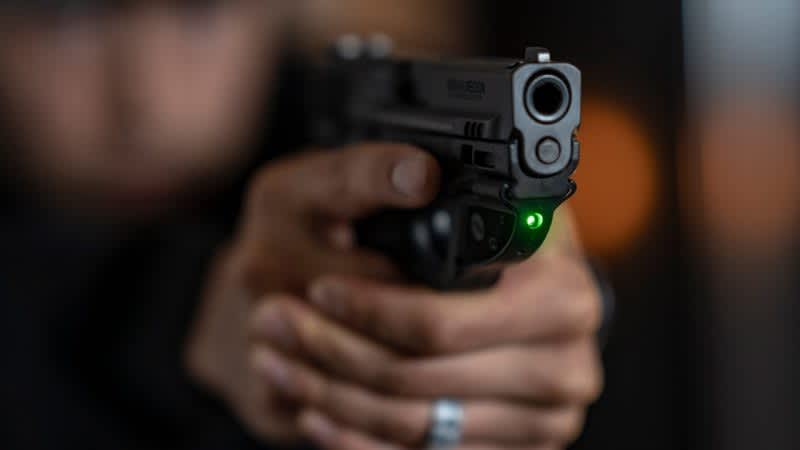
1. Lasermax Guide Rod Laser - Editor's Pick
The great thing about the Lasermax Guide Rod Laser is that it solves the biggest challenge of adding a laser to a pistol: fitting it into your holster. What if you have a great IWB or concealed carry rig and don’t want to have to shop around for a new holster that will accommodate an attached laser?
The LaserMax internal guide rod laser answers this question by ingeniously incorporating the laser, battery, and internal electronics into the space usually occupied by the guide rod. The guide rod laser adds zero bulk, zero snag, and zero carry limitations to your firearm. You can upgrade to a laser while keeping your favorite soft tuck holster.
Naturally, the question arises whether a guide rod with internal batteries and electronics is as durable as the rugged piece of steel it replaced. There are a plethora of forums with gun owners wondering “Will the laser break?” “Will the gun jam?”, and “Will the weapon cycle effectively?” After extensive research into user experiences, the consensus is overwhelmingly reassuring. Isolated problems do exist, but there’s no evidence of any systemic weaknesses or concerns with using a Lasermax guide rod in place of standard solid metal.
Honestly, the biggest problem with the guide rod laser is that it’s only available for select handguns – currently, there are 35 models available for the most common offerings from Beretta, Glock, SIG, and H&K. Hopefully, Lasermax will continue to add new makes and models to their catalogue.
Weight: 0.4-0.76 ounces depending on model, but the “feels like” weight will be even less since you are subtracting the weight of your OEM guide rod
Specifications: < 5 mW power output, 532nm wavelength for green laser models, 633nm wavelength for red laser models
2. Streamlight TLR-6 gun light/laser - Best Light/Laser Combo
Do you like little guns and you cannot lie? Streamlight has you covered with the TLR-6, which somehow manages to pack both a laser and a weapon light into a compact package designed to attach to the trigger guard of your subcompact handgun. The TLR-6 has adapters for some of the lightest, slimmest 9mm’s in production, including the Sig P365, the Kahr PM9, and the “Baby Glock” Glock 26. (For a complete list of handguns compatable with the TLR-6 see this list.
Unfortunately, like the Lasermax above, there’s limited offerings for handgun outside the mainstream options, but there’s still quite a few options here.
The TLR-6 is not a rail mounted laser — it attaches to the trigger guard, which makes it a great option for subcompact handguns without a picatinny rail, such as the Glock 43.
Streamlight offers a “universal kit” which includes 6 separate housings; a great option if you want to try the TLR-6 out on different handguns. Or, for a lower price, you can purchase the laser with the dedicated housing for your specific gun.
Sorry, fellow CZ RAMI fans — there isn’t yet a trigger mounted housing for the 2075. Guess we can keep waiting and hoping.
If you want to put a laser and a light on your subcompact, the Streamlight TLR-6 may be your best option, especially if your subcompact doesn’t have an accessory rail.
Weight: 1.12 – 1.27 ounces depending on model
Specifications: 640-660nm wavelength, power <5mW
3. Crimson Trace CMR-201 Rail Master - Rail Mount Pick
If your carry gun has a Picatinny M1913 or Weaver-style accessory rail, the CMR-201 may be your best option. The CMR-201 is packed with features, such as dual side activation and instant activation, but it also manages to have a “barely there” feel to it that many reviewers are quick to comment on.
I like the way this particular model snugs up into the corner between the outside of the trigger guard and the underside of the frame, reducing snag points and keeping the controls readily within a finger’s reach. While a chunky weapon light or accessory does add a cool, futuristic look to a handgun, the CMR-201 suggests a more understated, but practical look and feel.
The CMR-201 utilizes Crimson Trace’s “Secure-Lock Technology™” for a recoil-proof setup and consistent accuracy.
If you shopped around for a handgun with a rail and were already planning your holster options around having a rail-mounted laser, you can’t go wrong with the CMR-201.
Weight: 1 ounce
Specifications: 5mW peak power output, 633nm wavelength
4. Crimson Trace Laser Grip Series - Grip Pick
The line of Crimson Trace laser grips is a great option if you’re looking to add a laser to your handgun without compromising on holster selection. As the name suggests, the laser grips are essentially replacement grips panels — with a built in laser on one side.
Although your ability to use this option is limited by whether Crimson Trace has manufactured laser grips for your particular handgun, they currently have a robust selection. At the time of writing, there are 91 different laser grip makes, geared toward popular handguns. These include 1911’s, Glocks, Sigs, Berettas, Kimbers, S&Ws, and others. There’s also some options for less common handguns, which makes me think the manufacturer’s at Crimson Trace might have thrown in a few of their personal favorites.
Continuing the sad story of the sidelined CZ RAMI, there’s not yet a Crimson Trace Laser Option for the CZ 2075. The absence of any aftermarket lasers for this particular handgun can only mean one thing: companies don’t bother making laser sights for the most accurate handguns.
The Crimson Trace Laser Grips stand out from the competition in another notable way — they’re one of the very few (maybe only) options for putting a laser sight on your revolver. The revolver community has really been left behind when it comes to laser sights/weapon lights — and there’s a good reason for this. Putting an accessory rail on a revolver underlug might tempt shooters to have their fingers stretched out across the cylinder gap to actuate their light or laser while firing. A bad habit which could result in the dreaded cylinder gap injury.
Crimson Trace gives revolver lovers an option with a number of laser grips for various sized Ruger and S&W revolvers. These grips may also work on Taurus or other models, but buyer due diligence is required to ensure proper fit.
Another big advantage of Laser Grips is the intuitive on/off operation, as the laser activation button is automatically pressed by the dominant firing hand. As Crimson Trace puts it: “when you hold your gun in a normal firing grip, the laser is on.”
In addition to the grip activation switch, there’s also a master “on/off” switch which allows you to manually power down the whole laser so it won’t shine when gripping the gun. This is a good option if you ever find yourself in a situation where you want to hold your handgun at the ready without advertising your position with a shiny red dot.
Crimson Trace didn’t skimp on grip design either, and offers the grips in a variety of premium styles, and textures, including some very nice rosewood panels. As you can imagine, all of this comes at a price, and the grip lasers are one of the most expensive options for adding a laser to your handgun.
Weight: Varies, depending on model
Specifications: 5 mW power output, 532nm wavelength for green laser models, 633nm wavelength for red laser models
5. Laserlyte Laser Sight/Trainer - Training Pick
The Laserlyte trainer/sight attaches to your picatinny rail, and comes with two body sizes to adapt to different size handguns. Like the Streamlight TLR-6, setup takes a little bit of time as installation is achieved by taking apart the sight and then reassembling the two haves around the picatinny rail.
The unique thing about this offering from Laserlyte is that it’s both a laser sight, and a laser training device. You can press a button to turn the laser on and off for aiming, but when you pull the trigger and drop the hammer/striker on a snap cap, the laser is sound-activated and briefly pulses. This enables it to be a training device for use with laser targets, also offered by Laserlyte and other distributors.
This may be a good option for someone who wants a laser sight, but also wants to practice dry-firing with a laser. Instead of buying two separate lasers, you can buy this.
This is a budget option, the cheapest laser on this list, so don’t expect it to compete with Streamlight or Crimson trace in terms of quality, ruggedness, and accuracy. However, it’s an interesting option that fills two niches at once and comes with a reasonable price tag.
Weight: 1.12 ounces
Specifications: < 5mW power output, 630 – 670nm wavelength
Looking at laser power specifications
If you’re still reading, you must really like lasers, so let’s take a moment to talk about what the power specifications on each laser mean. If you’re not an engineer, physicist, or science geek, the numbers may be confusing, so here’s a quick explanation.
Typically, a laser will have two measurements: wavelength (measured in nanometers or “nm”), and power (measured in miliwatts, or “mW”). Do these numbers matter at all?
The short answer is: not really. Most pistol lasers fall into the category of class 3R lasers (also referred to as IIIA, or 3A):

Class 3R lasers produce a power output at or less than 5 milliwatts (mW). This low power generates a bright dot visible at a distance, and can cause some degree of eye damage if viewed directly at close range. For an extreme comparison, the actual laser weapons used aboard U.S. naval vessels have a power rating somewhere around 15–50 kW, making them 15-50 million times more powerful than a pistol laser.
Unless you’re buying a cheap knockoff that’s attempting to trick you into putting a class 2 laser pointer on your handgun, commercially available class 3R/3A lasers are all essentially the same — with one notable exception.
Which is better, green or red for a laser sight?
That’s really the only practical scientific consideration you need to worry about when picking a pistol laser. Green lasers are brighter, and will show up better in daylight than red lasers. You need to pick what is best for you.
We are committed to finding, researching, and recommending the best products. We earn commissions from purchases you make using the retail links in our product reviews. Learn more about how this works.

